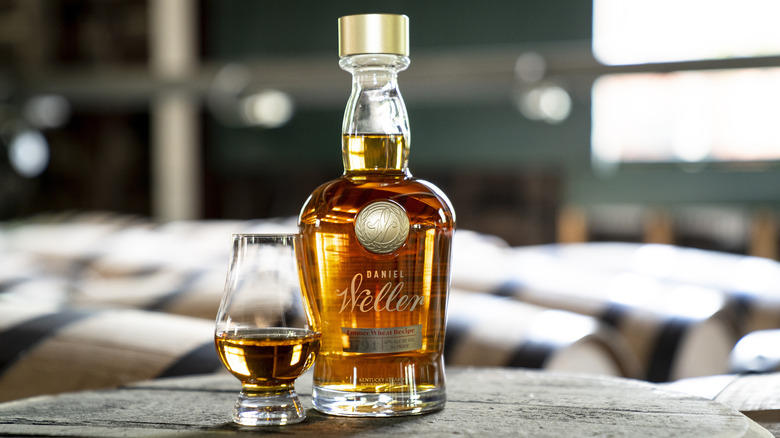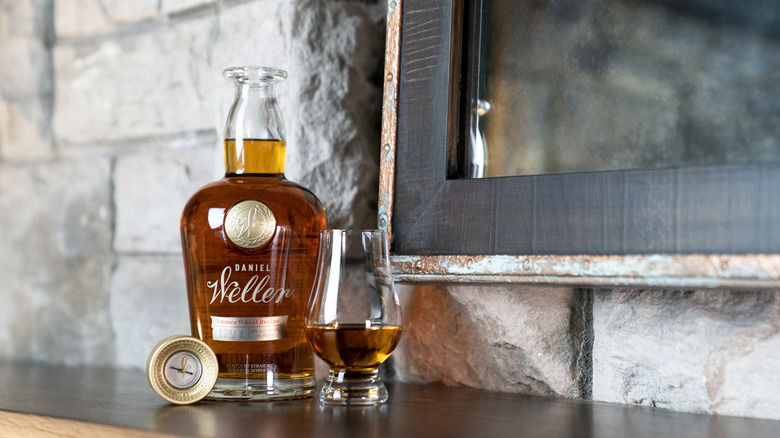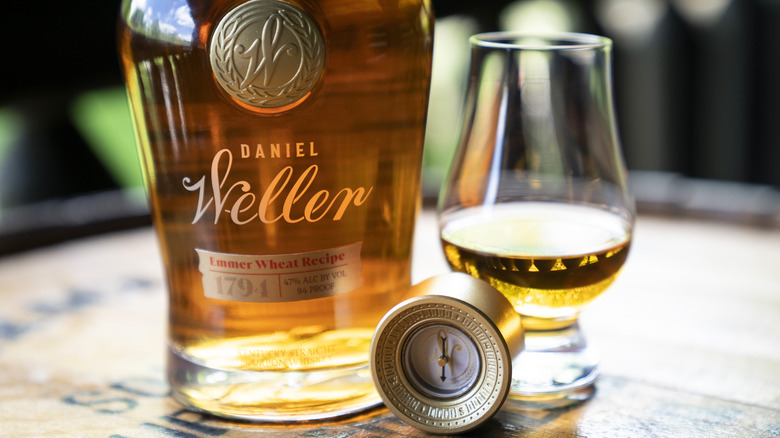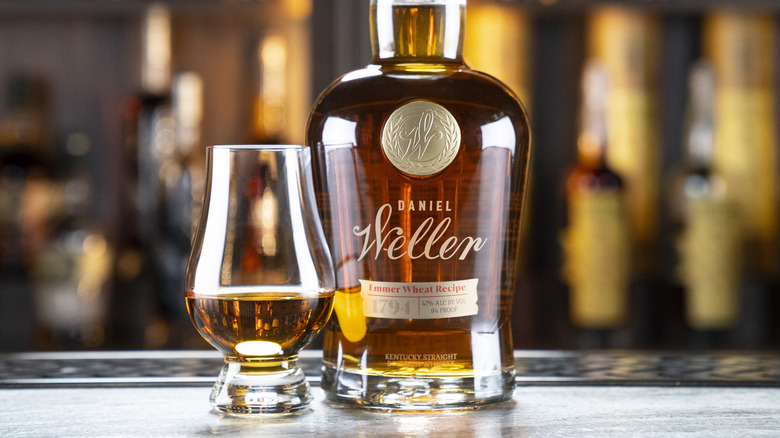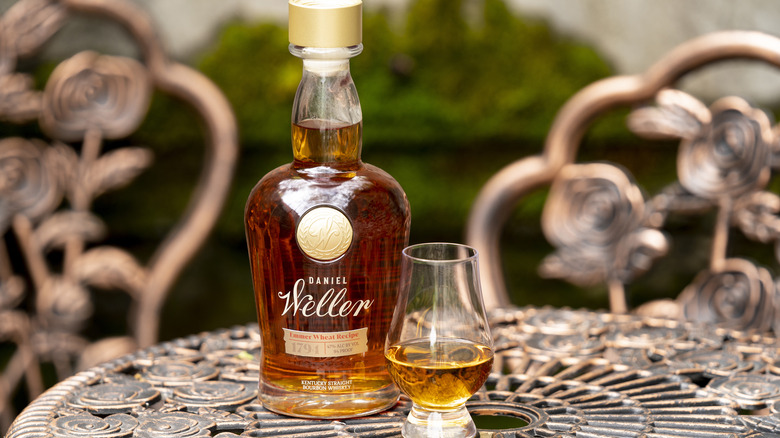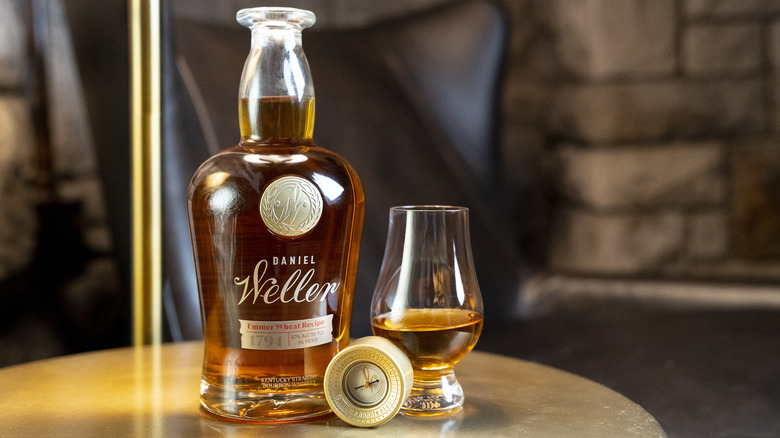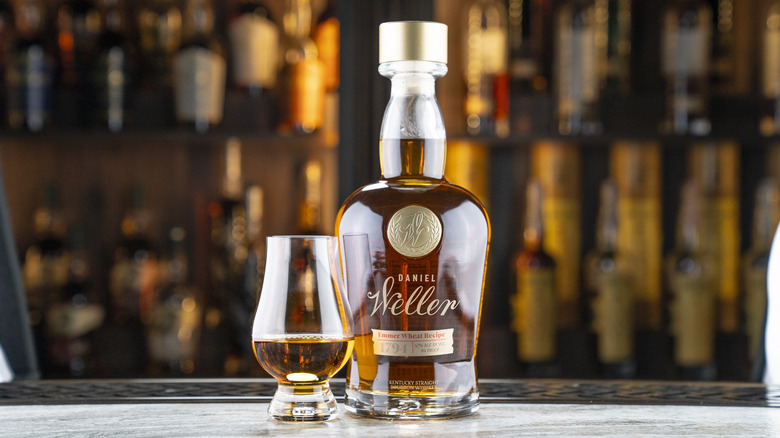Review: Daniel Weller Emmer Wheat Is A Novelty Bourbon Worth The Investment
Daniel Weller Emmer Wheat is the first in the new series from Buffalo Trace, which will release bottles biannually and experiment with variations in W.L. Weller's famous wheated mash bill. We got to sample the new label at a special tasting event in the company of many of New York's whiskey cognoscenti. Master Distiller Harlen Wheatley led the tasting, accompanied by his son Jett, who is also a distiller.
People who hate to love Weller be warned: Daniel Weller Emmer Wheat 1794 isn't going to make your beloved bourbon brand any easier to find (or pay for), but it will further solidify the squat bottle's place as a discerning dram. Buffalo Trace is going to be doing a lot of these types of experiments. Wheatley spoke about how various warehouses have different features to emphasize results and traits: some lean into scientific control of variables down to a micro-level, while others let it ride to see what surprises can enter the fray.
The pair guided us from the Weller Special Reserve, to the Weller C.Y.P.B., the Weller 12-Year, and to the debut of the Daniel Weller Emmer Wheat — a bottle only Sazerac employees had tasted prior to that evening. And there are going to be more strains of wheat in Daniel Weller's future. Here's the rundown along with our tasting notes and review.
What is Daniel Weller Emmer Wheat bourbon?
In an era when Scotch whisky is turning its focus to terroir, and it seems every other U.S. distiller wants to experiment with double oaking, the Weller lineup is zeroing in on the mash bill. That might make a few folks scratch their heads as Weller famously only has one mash bill, which makes it one of the most sought-after wheated bourbons on the market.
Well, it turns out, it's not just how much wheat you use but what kind. With the same mash bill as other Weller expressions, Daniel Weller Emmer Wheat 1794 makes one significant change: substituting red winter wheat with emmer. Emmer wheat is an ancient grain — considered the original cultivated wheat, although, it's neck and neck with einkorn — that noticeably alters the Weller product.
Although to be fair, there are two other factors at play. The first is that Daniel Weller is aged for almost 12 years, putting it pretty close to W.L. Weller 12, a.k.a. the "Black Label" and our pick for best of the regular series thus far. The second is that this batch was distilled in the E.H. Taylor, Jr. Microstill, a combination pot and column still of Wheatley's own design intended for small batch experiments.
Who was Daniel Weller?
While whiskey enthusiasts likely know the name William Larue Weller, or at least the W.L. Weller label, almost none have heard of his grandfather Daniel Weller, who moved his family to Kentucky by boat in 1794. There, he set up shop as a rye distiller, which was already a family business going back to at least his own father Johannes.
In fact, the Larue in his grandson's name refers to LaRue County, Kentucky. Location is obviously such a huge part of bourbon production with Kentucky's famous limestone water credited with its quality. Turns out it's a huge part of the Weller legacy as well. For that reason, this bottle comes with a hefty stopper that has a compass built into it, as well as the GPS coordinates for Daniel Weller's farm on the underside. Like Daniel, you'll start your whiskey journey with an idea of where you're going, and end it by settling in place with that longitude and latitude.
Okay, it's a gimmick, but it's a pretty cool one.
Where can I buy Daniel Weller Emmer Wheat?
Unfortunately for most whiskey drinkers, Daniel Weller Emmer Wheat is an extremely limited production. If you know of a retailer or hospitality venue that has a longstanding good relationship with Buffalo Trace or Sazerac, particularly with a focus on Weller, you might inquire of them whether they're one of the lucky recipients of these allocated bottles. It's just possible you can score a pour at your favorite bar or restaurant, but if you're looking to nab the whole 750 mililiter, it will be a case of finding a liquor store that cultivates a culture and curates its collection beyond the norm.
More bad news if you're in it for the love of the juice. Even if you can find this carefully distributed expression, Daniel Weller Emmer Wheat will cost you $500—at least on paper. The reality is that a small release of a much sought-after bottle will rise simultaneously on shelves and the illicit secondary market, particularly for a bottle that can no longer be called "poor man's Pappy." The last few years, Weller bottles have been chasing all the price hikes that appellation entails. Deservedly so if you ask us. Still, early speculation thinks $1000 is a reasonable expectation for these, although whether that's a reasonable price is a different debate.
What does Daniel Weller Emmer Wheat smell like on the nose?
Put your nose in a tulip glass of Weller Special Reserve, then into the Daniel Weller, and you'll swear you're moving from peppermint to butterscotch. But, take Daniel Weller on its own and the olfactory impression is entirely one of whole wheat bread. This is both obvious and odd because, sure, why wouldn't a bourbon famous for its wheated mash bill smell like wheat? But, if that's the case, and if all of these use the same proportions of wheat to corn and malted barley, then the inescapable follow-up question is why don't they all? After all, the 12-year is aged the same length and doesn't present nearly the same nose.
The answer comes down to either the emmer wheat used, the special still, or some combination thereof. Personally, our money is on the ancient grain. It makes sense that the primal strain of wheat could have an untamed aroma before its descendants were domesticated for desirable qualities.
What does Daniel Weller Emmer Wheat taste like?
The better question is what doesn't Daniel Weller Emmer Wheat bring to the table? It's sort of an omni-bourbon spectacularly positioned between fruit, nut, wood, spice, and the more bitter notes that encapsulate the major bourbon flavors. Of course, that's rather the case for all of Weller's lineup and part of the reason for its popularity. You're never biting off a knob of oak with every sip, drowning in cherry flavor, or any of the other pitfalls and attractions that characterize whiskeys outside of the center.
With that disclaimer, we got a lot of spice and leather here, which isn't too surprising given the longer aging that tends to exacerbate stronger flavors. And just as with the nose, the wheaty taste is much more notable than the rest of the lineup. Critics often cite how wheat softens and sweetens a whiskey without making it cloying. It's only when you encounter a bourbon like Daniel Weller that you realize you almost never detect an essence of wheat directly as you more often do its effects.
Is Daniel Weller Emmer Wheat worth tracking down?
For the old-school bourbon enthusiasts who still complain that the rest of the world has discovered Weller and driven the price up, this bottle might not make any friends. For our money, the W.L. Weller 12-year has a slight edge on Daniel Weller. That's a personal taste and we'd tell you the same about the brand's C.Y.P.B. label and, yes, maybe even the widely hailed William Larue Weller from the Buffalo Trace Antique Collection that we were far from disappointed by but wondered how much room there was for improvement.
That said, the most comparable price point to Daniel Weller Emmer Wheat 1794 is Weller Full Proof — at least if you manage to find Daniel for its suggested $500 and not an immediate markup to $1,00 or (so help you) even higher. And if you're sitting there trying to decide between W.L. Weller Full Proof and this new edition, let us make it easy on you: Go for the novelty.
